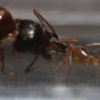- Formiculture.com
- Forums
- Gallery
- Members
- Member Map
- Chat

Mites problem
Started By
zpiter
, Sep 10 2016 6:27 AM
6 replies to this topic
#1
 Offline
-
Posted September 10 2016 - 6:27 AM
Offline
-
Posted September 10 2016 - 6:27 AM
Hi guys, I caught two carebara months ago and both of them aren't doing so well. I had them in a dirt setup at first but after I realize they keep eating their eggs, I moved them to test tube setup to have a better look into the situation.
One week after transferring them into test tube setup, which is last night, I went to check on them. To my shock I found dozens of mites all over the test tube and on the queen's body.
I read about using lemon juice to get rib of the mites but I believe I shall ask any guys here that had face this issue and get it fix.
One week after transferring them into test tube setup, which is last night, I went to check on them. To my shock I found dozens of mites all over the test tube and on the queen's body.
I read about using lemon juice to get rib of the mites but I believe I shall ask any guys here that had face this issue and get it fix.
#2
 Offline
-
Posted September 10 2016 - 1:45 PM
Offline
-
Posted September 10 2016 - 1:45 PM
Some species of Carebara have really big queens with miniscule-sized workers. Better hope it's that, because if they are mites, then the queen is a gonner.
- LC3 likes this
byFormica® is the manufacturer of the iconic nectar feeders and Sunburst Ant Nectar.
byFormica ant products always deliver consistent performance, convenience,
and reliability, making them among the most beloved ant foods and kit enjoyed by
ant keeping enthusiasts worldwide. For more information, visit www.byFormica.com.
#3
 Offline
-
Posted September 10 2016 - 2:11 PM
Offline
-
Posted September 10 2016 - 2:11 PM
Well you need to find out if they are parasitic mites before drawing any conclusions.
- LC3 likes this
#4
 Offline
-
Posted September 10 2016 - 3:54 PM
Offline
-
Posted September 10 2016 - 3:54 PM
Well you need to find out if they are parasitic mites before drawing any conclusions.
My phone doesn't allow me to take clean photo of it, but it is a parasitic mites.
#5
 Offline
-
Posted September 11 2016 - 9:44 AM
Offline
-
Posted September 11 2016 - 9:44 AM
During the Lasius flights up here this week, one of the male alates I saw had a couple reasonably good sized mites on it. Probably more common on the alates than we realize.
#6
 Offline
-
Posted September 11 2016 - 11:04 AM
Offline
-
Posted September 11 2016 - 11:04 AM
During the Lasius flights up here this week, one of the male alates I saw had a couple reasonably good sized mites on it. Probably more common on the alates than we realize.
There are a few mite species that are endemic to exclusively Lasius, while other species use ants for transport/distribution, not feeding on the ants themselves. I learned a few things about ant/mite associations from glossing over a few pages from this book:
Mites: Ecology, Evolution and Behaviour
Edited by drtrmiller, September 11 2016 - 11:05 AM.
- noebl1 likes this
byFormica® is the manufacturer of the iconic nectar feeders and Sunburst Ant Nectar.
byFormica ant products always deliver consistent performance, convenience,
and reliability, making them among the most beloved ant foods and kit enjoyed by
ant keeping enthusiasts worldwide. For more information, visit www.byFormica.com.
#7
 Offline
-
Posted September 11 2016 - 11:32 AM
Offline
-
Posted September 11 2016 - 11:32 AM
The common parasitic mites that I see, I can easily recognize. I find them on new queens every so often. Fortunately, with a microscope and my fifty dollar pair of forceps, I'm able to remove them without too much trouble.
1 user(s) are reading this topic
0 members, 1 guests, 0 anonymous users















